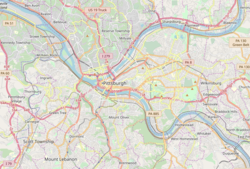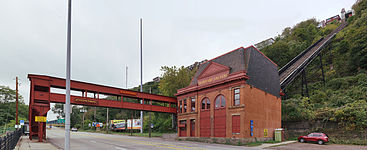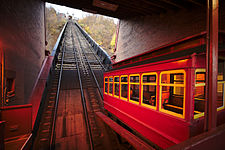| Duquesne Incline | |
|---|---|
 View of the incline from its upper station, with the Golden Triangle in the background View of the incline from its upper station, with the Golden Triangle in the background | |
| Overview | |
| Owner | Pittsburgh Regional Transit |
| Locale | Pittsburgh, Pennsylvania |
| Website | www |
| Service | |
| Type | Funicular |
| Operator(s) | Society for the Preservation of The Duquesne Heights Incline |
| History | |
| Opened | May 17, 1877 (1877-05-17) |
| Technical | |
| Line length | 800 feet (244 m) |
| Track gauge | 5 ft (1,524 mm) |
| Maximum incline | 30 degrees |
| Duquesne Incline | |
| U.S. National Register of Historic Places | |
| Pittsburgh Landmark – PHLF | |
   | |
| Coordinates | 40°26′21″N 80°1′5″W / 40.43917°N 80.01806°W / 40.43917; -80.01806 |
| Built | 1877 |
| Architect | Samuel Diescher |
| Architectural style | Second Empire, T pattern |
| NRHP reference No. | 75001609 |
| Added to NRHP | March 4, 1975 |
The Duquesne Incline (/djuːˈkeɪn/ dew-KAYN) is a funicular scaling Mount Washington near the South Side neighborhood of Pittsburgh, Pennsylvania, United States.
The lower station is in the Second Empire style. Together with the incline, which rises 400 feet (122 m) in height, at a 30-degree angle, it was listed on the National Register of Historic Places in 1975. The incline is unusual for using a 5 ft (1,524 mm) track gauge, mainly used in Finland, Russia, and Mongolia.
Together with the Monongahela Incline, it is one of two passenger inclines still in operation on Pittsburgh's South Side. By 1977, the two had become tourist attractions and together served more than one million commuters and tourists annually. That year both inclines were designated as Historic Mechanical Engineering Landmarks by the American Society of Mechanical Engineers (ASME).
The incline is owned by Pittsburgh Regional Transit, and operated by the nonprofit Society for the Preservation of The Duquesne Heights Incline. Fares for the incline are standard Pittsburgh Regional Transit fares.
History
Originally steam powered, the Duquesne Incline was designed by Samuel Diescher, a Hungarian-American civil engineer based in Pittsburgh, and completed in 1877. The incline is 800 feet (244 m) long, 400 feet (122 m) in height, and is inclined at a 30-degree angle. Its track gauge is 5 ft (1,524 mm), which is unusual in the United States (but standard in Finland, Russia, and Mongolia).
Diescher is known for having designed the majority of inclines in the United States, including several in Pittsburgh and Pennsylvania, in addition to numerous other industrial and highway projects.
The incline was intended to carry cargo up and down Mt. Washington in the late 19th century. It later carried passengers, particularly Mt. Washington residents who were tired of walking up the steep footpaths to the top of the bluff. Inclines were being built all over Mt. Washington to serve working-class people who were forced out of the lowlying riverfront by industrial development.
But as more roads were built in the twentieth century on “Coal Hill”, as it was known, and automobile use increased, most of the other inclines were closed. By the end of the 1960s, only the Monongahela Incline and the Duquesne Incline remained in operation.
In 1962, the Duquesne Incline was closed, apparently for good. Major repairs were needed, and with so few patrons, the incline's private owners did little. But local Duquesne Heights residents launched a fund-raiser to help restore the incline. It was a huge success, and on July 1, 1963, the incline reopened under the auspices of a non-profit organization dedicated to its preservation.
The incline has since been totally refurbished. The cars, built by the J. G. Brill and Company of Philadelphia, have been stripped of paint to reveal the original wood. An observation deck was added at the top affording a view of Pittsburgh's "Golden Triangle". The Duquesne Incline is now one of the city's most popular tourist attractions. In 1975 it was listed on the National Register of Historic Places. By 1977 the two remaining passenger inclines served more than one million commuters and tourists annually. That year both inclines were designated as Historic Mechanical Engineering Landmarks by the American Society of Mechanical Engineers (ASME).
Specifications
- Length: 793 feet (242 m)
- Elevation: 400 feet (122 m)
- Grade: 30 degrees
- Gauge: 5 ft (1,524 mm) broad gauge
- Speed: 4.03 mph (6.49 km/h)
- Passenger Capacity: 18 to 25 (one compartment)
- Opened: May 20, 1877
- Renovated: 1888 (with steel structure)
- Rebuilt: Original steam power replaced with electricity: 1935
- Renovated: Historic cars restored in 1970s
In popular culture
- The incline is featured in the opening scene of The Next Three Days (2010) trailer. The same scene is featured about halfway through the film.
- It is also featured in the 1983 film Flashdance, set in Pittsburgh.
- In the 1987 movie Lady Beware, the characters played by Diane Lane and Cotter Smith ride the incline.
- The Duquesne Incline is a featured Pittsburgh landmark on Yinztagram.
Gallery
-
 Lower building
Lower building
-
 The view upward when ascending the incline
The view upward when ascending the incline
-
 Interior view looking toward the Pittsburgh skyline
Interior view looking toward the Pittsburgh skyline
-
 Lobby of the lower station
Lobby of the lower station
-
 Platform of the lower station
Platform of the lower station
-
 Drive gear and cable drum of the funicular
Drive gear and cable drum of the funicular
See also
- Angels Flight
- Funicular railway
- Johnstown Inclined Plane
- List of funicular railways
- List of inclines in Pittsburgh
- Monongahela Incline
References
- "The Duquesne Incline Plane". The Daily Post. Pittsburgh. May 18, 1877. p. 4.
- "National Register Information System". National Register of Historic Places. National Park Service. July 9, 2010.
- ^ Leherr, Dave (May 7, 1977). "Inclines Rise to National Landmarks". Pittsburgh Post-Gazette. p. 9.
- "About The Incline". Society for the Preservation of The Duquesne Heights Incline. Retrieved December 4, 2024.
- "Mobile Ticketing". Pittsburgh Regional Transit. Retrieved December 4, 2024.
- "Monongahela and Duquesne Inclines" (PDF). Archived from the original (PDF) on August 16, 2009. Retrieved May 21, 2009.
- ^ "Monongahela and Duquesne Inclines" (PDF). ASME. May 11, 1977.
- "Yinztagram By Pegula". iTunes Store. Apple Inc. 2012. Archived from the original on August 28, 2012. Retrieved December 13, 2012.
External links
- Official website

- Pittsburgh Regional Transit: How to Ride the Inclines
- Travel Channel video of Incline
- HawkinsRails' Duquesne Incline scrapbook
- View on Google Maps
| Pittsburgh Regional Transit | |||||
|---|---|---|---|---|---|
| Light rail | [REDACTED] | ||||
| Inclines | |||||
| Buses and busways | |||||
| Former lines |
| ||||
| Equipment |
| ||||
| Infrastructure | |||||
| Public transportation in Greater Pittsburgh | |
|---|---|
| Bus services | |
| Bus rapid transit | |
| Light rail | |
| Inclines | |
| Amtrak | |
| Airports | |
| Stations |
|
| Discontinued | |
- Industrial buildings and structures on the National Register of Historic Places in Pennsylvania
- Funicular railways in the United States
- Tourist attractions in Pittsburgh
- Pittsburgh History & Landmarks Foundation Historic Landmarks
- Railway inclines in Pittsburgh
- Port Authority of Allegheny County
- 5 ft gauge railways in the United States
- National Register of Historic Places in Pittsburgh
- Cableways on the National Register of Historic Places
- Rail infrastructure on the National Register of Historic Places in Pennsylvania
- Historic Mechanical Engineering Landmarks
- Railway lines opened in 1877
- 1877 establishments in Pennsylvania
- Industrial buildings and structures in Pittsburgh

